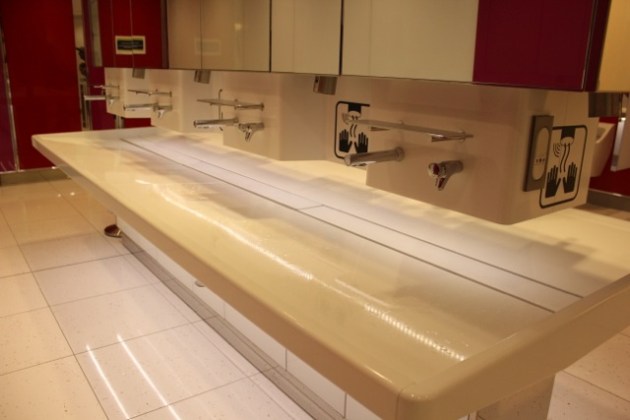To paraphrase the beginning of the article from the New York Times titled “Why We Love Beautiful Things“, great design is like pornography, you know it when you see it. And it was instantly recognizable, design that is, when I was at a men’s restroom in Terminal 2 of Charles de Gaulle airport a few weeks ago.
Now an airport restroom may seem like the unlikeliest place to encounter great design. However, the architects and designers at CDG must have paid a lot of attention to the typical problems in restrooms and rather than build the typical structure, they have really injected new thinking into it.
This photo shows the tap area where you wash your hands, which is where a design revolution has taken place!
Notice the differences from the typical.
1. No bowl sinks. Instead there is a slab that slants towards the middle and the water automatically just gets rolled off and collected in the slightly depressed center part of the structure. No problem of the water spilling outside the bowl and creating a wet mess. You also don’t have to move your hands up and down trying to position them just so in front of the motion sensor for the tap to work. The tap is at a comfortable height and yet not too high for water to bounce off the slab on your clothes.
2. The hand dryer is right next to each tap. This way you don’t have to carry your wet hands around the restroom in search of a dryer or the paper towel dispenser, dripping water along the way, making the floor wet, and at times waiting for the person before you to finish drying his hands. By habit I was going to write “his or her hands”, but then I realized I am writing about my experience in a restroom! And the dryers were really good at their job of drying hands.
3. The floor also slants slightly inwards towards the center, presumably making it easier to clean the floor and have the soap and cleaning agents just get collected in the center of the restroom.
It was refreshing to see this design and the thought gone into implementing it. Great design creates a lasting impression, and so it was not surprising that both me and my wife came out of the respective men’s and women’s restrooms and the first thing we said to one another was “Did you see that restroom?” I don’t remember ever having that kind of thought coming out of such a place.
User experience and design thinking is an art and science into itself, and I am not going to talk about what makes for great design and therefore great experiences. However, companies that are serious about user experience and design evolve their capabilities along a maturity curve.
1. Consistent ‘Look and Feel’ and Styling
I have heard many executives lamenting the fact that multiple products from the same company do not have a consistent look and feel, or even consistent styling and branding elements. This is not by choice of course, but typically “features” tend to take precedence over “experience”. Also, user experience and design skills are not necessarily present in all development teams. Mergers and acquisitions also add to the mix.
So most companies start off with the goal of at least bringing some consistency to the user interfaces of their products, ensuing a good and consistent “look-and-feel”. They develop and implement style and brand guidelines to be used by the product teams. The next development cycle is identified where the product gets a makeover. This is a good first step. This would be like giving the restroom a fresh coat of paint or new colors.
2. Design Thinking
The second milestone along the maturity curve is of leveraging design thinking to create a fundamentally unique experience with the product. The idea is to solve the same set of problems and accomplish the same set of goals, but by providing a radically different interface and experience. For this to happen effectively, design is involved right upfront in the development process. In addition to “functional goals” which provide objective benefit and value, there are now “design goals” that increase subjective value of the experience to the point of creating delight. It requires a fundamental rethinking of the workflow and, for information intensive products, a rethinking of the information architecture – sources, uses and movement of information. This is what we see in the case of the Paris airport restroom.
3. Design Competency
The third milestone is reached when the design capabilities evolve over time to such an extent that design becomes a core competency and delivers unfair advantage to the product and company. Great design itself becomes an element of the brand. It enables a company to not just solve the same set of problems and accomplish the same set of goals, but to leverage the expertise to solve a completely new set of problems. Apple has demonstrated this time and again, leveraging their core competency in design to deliver products beyond the personal computer, and delivering blockbuster hits in the form of a music player, a phone and a tablet. It is interesting to see people wondering what everyday objects like a car, house or say a fighter plane (!) would look like if Apple designed it. Steve Jobs summarized it well at the launch of the iPad2 when he said:
It is in Apple’s DNA that technology alone is not enough—it’s technology married with liberal arts, married with the humanities, that yields us the results that make our hearts sing.
I am not implying that the CDG designers have not reached the third milestone of the maturity curve. I am sure they are working on making CDG a futuristic airport such that the airport experience might actually add to the romance of the city rather than taking away from it. The restroom is a good place to start.

